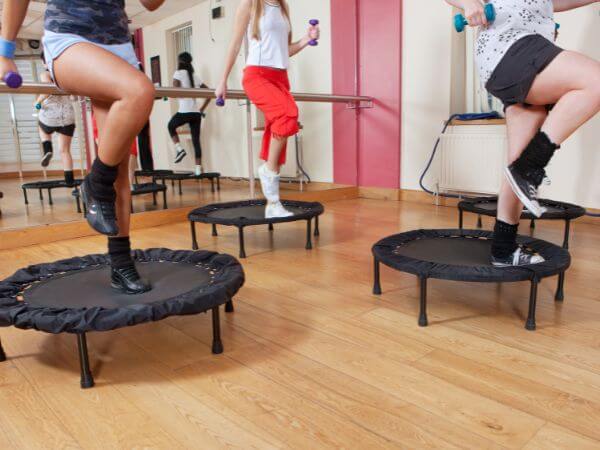The first time I tried jumping on the trampoline was at a kid’s birthday party. I never thought I had it in me… but I did.
I already knew about the famous NASA rebounding study claiming that this type of exercise is more efficient than running on the treadmill, both for cardiovascular training and energy expenditure.
So when my gym introduced a rebounding class, I had to try it.
That’s how I discovered the challenges along with the benefits of rebounding. I’ll delve into all that in the article below.
Table of Contents
How Much Weight Can You Lose Rebounding?
Depending on your weight, you may need just five hours of rebounding to shed one pound.
A study conducted at the University of Wisconsin shows that mini-trampoline workouts burn 12.4 calories/per minute for men and 9.4 calories/per minute for women.
That gives a total of 654-744 calories/hour.
Considering that one pound is the equivalent of 3500 calories (though the science behind burning calories is more complex than that), you will need about 4.5-6 hours of rebounding to fire up that pound.
Why can rebounding torch so many calories?
I’ll explain below:
Intense Cardio

Rebounding is an intense cardiovascular activity, just like the smart people at NASA first noticed four decades ago (yes, that’s when the ‘80s happened).
And since your body needs more energy to sustain this intense activity, it will have to use the extra carbs or fat cells in your body.
Those fat cells begin to burn with high-intensity effort when your heart reaches the anaerobic or VO2 max zones.
Here’s the catch:
You want to choose the right rebounding workout to keep that fast-paced burn in high gear until you reach your weight goals.
That usually means:
- Doing High-Intensity Interval Training (HIIT). Alternating the high and low periods has one major advantage: you can elevate your heart rate greatly during the intense intervals because they’re short. As such, these intervals maximize your fat burn. Besides, keeping your body guessing instead of allowing it to get in a steady-state cardio zone accelerates your fat burn even after the workout. Several studies attest that HIIT accelerates your metabolism for 48-72 hours after completing the routine.
- Taking rest days. As mentioned above, it’s important to keep your body guessing; otherwise, it will go into energy conservation mode. You also want to give your muscles plenty of time to recover so they can withstand the maximum effort during your next workout.
In my case, my gym rebounding workouts get my heart rate into the high aerobic-low anaerobic zone, usually around 150 bpm during the most intense phases and 120 during the low intervals.
That way, I can burn about 400 calories during a 45-minute workout on the mini-trampoline.
But that’s not all. Rebounding has another advantage:
Low Perceived Effort
Intense cardio is… well, intense. And many people dislike that, including me.
I know that many reputable health experts recommend 150 minutes of cardio per day. I know that bouts of high-level activity are good for my heart.
And I do my part.
I recently started running and swimming. I try to do back-to-back strength sets for different muscle groups to keep my heart rate elevated on my strength training days.
But boy, do I hate the feeling.
Feeling my heart beating faster, feeling breathless, feeling sweaty… definitely not my cup(s) of tea.
Rebounding is different, though.
Thirty minutes of rebounding fly right by, and although I feel a bit out of breath, I also feel exhilarated.
That’s because the perceived effort you feel when rebounding is much lower. The potential explanations include:
1) You’re happier because you’re jumping like a little kid. Also, intense exercise releases serotonin and dopamine, hormones responsible for giving you a more joyful mood. These hormones are also shown to reduce fatigue during intense exercise.
2) You’re using your entire body at once, which means you’re burning more calories and getting your heart rate up without feeling it.
Why does this matter?
Well, because you might quit a vigorous form of exercise if it gets too tough.
Even if that exercise would eventually help you reach your weight goals, it may not feel worth it if you feel miserable.
Conversely, jumping on the mini-trampoline makes you feel happy and invigorated.
That’s a definite plus for motivation if you plan to continue your weight loss journey.
Scalability

How often did this happen to you:
You try to lose weight, start a new routine, everything goes great at first and then… bam! You plateau. You reach a point where you can’t lose weight anymore.
Or, to make things worse, you actually start gaining pounds again.
That usually happens with cardio, not so much with strength training, which is more scalable.
That’s where rebounding stands out from the crowd in aerobic training: several studies show that both overweight newbies and muscular athletes can challenge themselves thoroughly on the mini-trampoline.
In one study, both groups reached high heart rates and oxygen consumption. As the authors conclude, these observations indicate that rebounding works for a wide range of fitness levels.
Therefore, chances are high that you won’t reach a plateau with this type of training – if you choose the right rebounding exercises.
Decreased Water Weight
Rebounding helps you get rid of water weight because it improves your circulation.
In fact, rebounding is one of the few exercises that increase lymphatic circulation.
If you have swollen lymph nodes, you know there isn’t much you can do about them. There’s no good off-the-counter or prescription medicine to target them. You can do lymphatic massage or acupuncture with moderate success.
However, rebounding allows that lymph to move through your body, reducing inflammation.
The secret, apparently, is in that half-second when you’re in a zero-gravity state at the top of each jump, followed by a double-gravity state when you fall down.
Why does that matter?
Lymphatic drainage helps you stay healthier because your body can eliminate toxins. But it also helps you get rid of water weight and cellulite.
The first time I jumped on a trampoline with those kids, I could feel my skin getting red and itchy. That’s a good first sign that your circulation is accelerating.
After a few rebounding sessions, I noticed feeling less bloated. I also sometimes wake up with swollen fingers, but not after I began those mini-trampoline workouts.
Can Rebounding Reduce Belly Fat?

Yes, rebounding can reduce abdominal fat.
Here’s why:
Firstly, you cannot spot-reduce belly fat. However, reducing fat throughout your body will decrease your deep-tissue abdominal fat.
Science is on our side:
Several studies tested participants’ body compositions during weeks of mini-trampoline jumping. Their results show that, indeed, a consistent rebounding program stretching for 3-5 months can help people lose body fat.
What is the explanation?
- Rebounding accelerates your metabolism, even when you’re at rest. That means you can burn through your carbon-based energy sources faster. Afterwards, your body can start burning fat for fuel, decreasing fat stores.
- Rebounding puts your heart rate in the fat-burning zone when your body consumes fat instead of glucose to get the needed energy.
Of course, improving your overall circulation and lymphatic drainage will also help your body burn more fat.
And remember that rebounding makes you feel happier. When stabilizing your hormones, your whole body functions better, including its ability to burn stored fat. By comparison, stressed states of increased cortisol make your body hold onto those fat stores.
Also, I dare you to notice how your abs behave when you first start rebounding.
You’ll notice they contract almost immediately to keep your balance. And you’ll need a lot of balance during those workouts since there are a lot of twisting and stability-challenging moves.
Although creating more lean muscle in the abdominal area won’t burn the surrounding belly fat, it does create this effect.
Those stronger abs will soon start showing, especially if you lose weight and fat throughout your body.
How Long Does It Take?
You will need about six hours on the mini-trampoline to burn a pound of weight.
However:
- You need to stay consistent with your routine. The studies we cited above all last for 12-20 weeks.
- You’ll want to challenge yourself. The participants’ routines were moderate to intense, and I also advise you to look for HIIT rebounder workouts. That way, you can challenge yourself and ensure your body keeps burning calories long after completing your training.
Some health and fitness experts argue that exercising is not enough to lose weight consistently.
You may also need to adjust your diet to eat healthy fresh produce and reasonable portions. Additionally, you need to keep yourself active throughout the day.
How Often Should I Rebound to Lose Weight?
To keep your progress consistent, you should rebound approximately thrice weekly.
Some of the studies cited in this article have participants for rebounding workouts four times per week. And these exercises may last for up to an hour and a half.
Newbies beware!
Trying to jump into long, exhausting workouts is a surefire way to lead you away from exercise and your weight loss plans.
Read more: 20 Possible Negative Side Effects of Rebounding
Know that even ten minutes of rebounding once per week is good enough at first until you build the habit of exercising.
The world is your oyster after that.
Maybe you enjoy mini-trampoline jumping each morning before work, or perhaps you discover the joys of strength training.
The important thing is to keep an open mind, listen to your body, and use the rebounder as a tool instead of an end goal.
- 7 Exercises for Pregnant Women in the First Trimester: Safe and Effective - January 30, 2025
- Our equipment recommendations - October 30, 2024
- Here’s What Doing Cardio Every Day Does To Your Body - August 21, 2024


I have hypothyroidism. I recently bought a rebounder in the hopes to build muscle strength and lose weight. Is it possible to lose weight while rebounding…if so, when can I expect to see results if rebounding at a beginner/moderate level for 30 minutes a day?